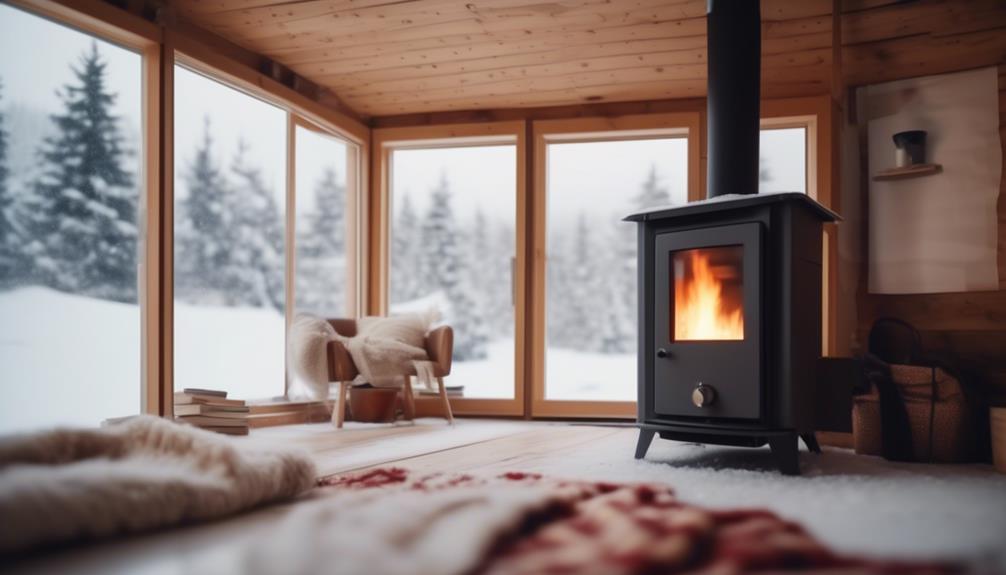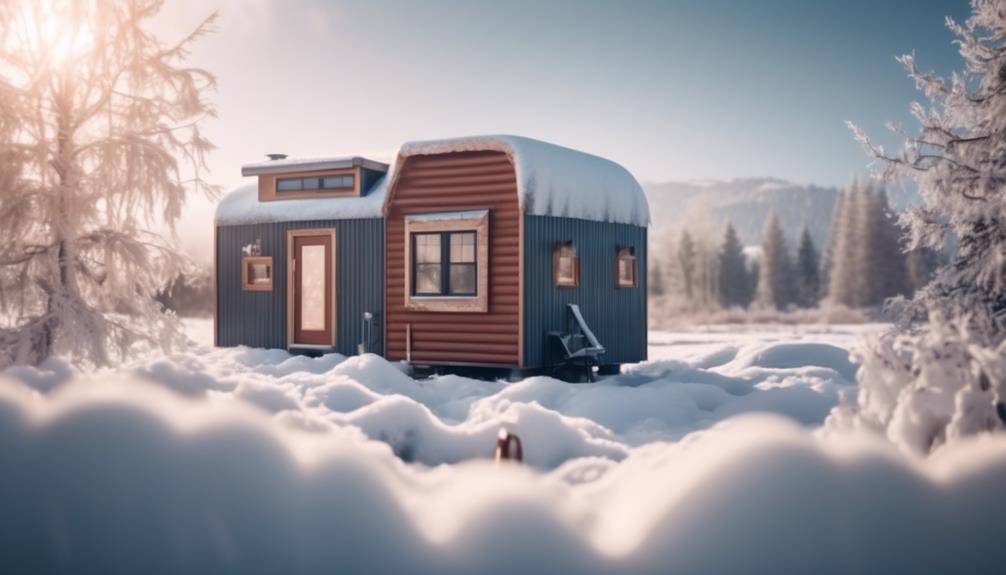As the mercury dips, so too should your tolerance for an ill-prepared abode; winterizing your tiny home isn't just a seasonal chore, it's your ticket to enduring comfort.
You've embraced the minimalist lifestyle, but let's not skimp on warmth. Insulation is your silent sentinel against the cold—do you know the vulnerable spots in your tiny haven? Sealing drafts effectively isn't just about stuffing old rags under the door; it's an art that requires a keen eye and a meticulous hand.
And when it comes to heating, size doesn't equate to efficiency; the choices you make here could be the difference between a cozy retreat and a chilly disappointment.
As you skirt the edge of winter's grasp, remember that your water system's integrity is only as strong as its weakest link. Now, consider this: what are the overlooked aspects of winterization, and how can ensuring their attention be the difference between bracing for the cold and embracing the season?
Key Takeaways
- Proper insulation is essential for maintaining thermal efficiency in a tiny home during winter. This includes using spray foam insulation with a high R-value, insulating the water heater, and employing solar shades or triple-pane windows.
- Sealing drafts is crucial to prevent cold air infiltration. Weather stripping, caulking, draft stoppers, and foam gaskets can be used to seal gaps and cracks in windows, doors, walls, floors, and ceilings.
- Efficient heating methods such as radiant floor heating and insulating propane tanks and pipes can help to ensure even heat distribution and prevent risks in low temperatures.
- Installing skirting made from nylon, banner fabric, or hard foam can serve as a windproof barrier and add aesthetic value to the tiny home while fortifying it against the cold.
Insulating Your Tiny Home
When winterizing your tiny home, selecting the right insulation is crucial, as options like spray foam can provide an R-value of up to R-31, significantly enhancing your home's thermal efficiency. For those dwelling in cold climates, this investment is essential. Spray foam not only serves as an extra layer to keep the house warm, but it also helps in mitigating moisture problems – a common challenge in compact living spaces.
Beyond walls, consider insulating your water heater and employing electric heaters for targeted warmth. Utilize a heated hose to maintain a liquid water supply, circumventing the inconvenience of frozen pipes. Don't overlook window treatments; solar shades or triple-pane windows offer additional protection against the cold.
Every tailored solution contributes to a cozy, efficient tiny house throughout the winter months.
Sealing Drafts Effectively
Sealing drafts is a critical step in winterizing your tiny home, as it prevents cold air infiltration and maximizes your insulation's effectiveness. In the tiny house lifestyle, where every square inch counts, ensuring a draft-free environment is essential to keep warm during the freezing winter months.
Here's an analytical guide to sealing drafts effectively:
| Draft Source | Sealing Solution |
|---|---|
| Windows & Doors | Weather stripping & Caulking |
| Door Bottoms | Draft Stoppers/Door Sweeps |
| Walls, Floors, & Ceilings | Inspect & Seal Gaps/Cracks |
| Outlets & Switches | Install Foam Gaskets |
Choosing Efficient Heaters

After addressing the drafts in your tiny home, it's crucial to select an efficient heater that complements your insulation efforts and suits the unique needs of your compact living space.
Radiant floor heating is a prime choice, offering even heat distribution and proving easy to maintain, a stark contrast to the intricate systems of a traditional home.
To keep the house cozy during freezing temps, safeguard your propane tanks with specialized coverings, mitigating risks when the temperature drops.
For those keen on RV Fresh Water Practices, ensure pipes are insulated against the cold, and consider heat tape to prevent freezing.
Skirting to Prevent Cold
To shield your tiny home from the biting winds of winter, consider installing skirting made from materials like nylon, banner fabric, or hard foam, which serve as effective windproof barriers. This skirting is essential to keep the cold at bay and maintain a warm interior.
| Material | Benefits |
|---|---|
| Nylon | Durable, windproof, cost-effective |
| Banner Fabric | Repurposable, sturdy, weather-resistant |
| Hard Foam | Insulating, sturdy, easy to install |
Skirting your tiny house not only adds to its aesthetic but also fortifies your home against the harsh cold. Local hardware stores will provide the necessary materials to start this critical winterizing step. Remember, a well-skirted tiny house is key to enduring extreme winter conditions and keeping your home cozy.
Maintaining Water Systems

Ensuring your tiny home's water systems remain functional during winter requires proactive measures. Here's a technical guide to safeguard your systems:
- RV Fresh Water:
- Install a heated hose to prevent your potable water from freezing.
- Plumbing Insulation:
- Wrap pipes with heat tape and insulation, focusing on vulnerable spots.
- Grey Water Disposal:
- Use a french drain system to avoid freezing in your grey water lines.
- Winterizing Tanks:
- Place heat lamps near your water tanks.
- Ensure they're below the permafrost line to prevent freezing.
Frequently Asked Questions
How Do I Keep My Tiny House Warm in the Winter?
To keep your tiny house warm, you'll need to explore insulation options, install thermal curtains, and consider floor insulation. Ensure air sealing, invest in efficient heating systems, and apply skirting methods for added protection.
How Do You Winterize a Tiny House?
To winterize your tiny house, upgrade insulation, apply window treatments, and explore skirting options. Block drafts, maintain the roof, and install flooring solutions. Manage interior humidity, seal doors, and caulk exteriors. Hang thermal curtains for efficiency.
How Do I Keep My Tiny House Water From Freezing?
To prevent your tiny house water from freezing, install pipe insulation, apply heat tape, and use a circulating pump. Consider skirt insulation, cabinet heaters, and thermal blankets for added protection against the cold.
Can You Live in Tiny House During Winter?
You can brave winter in a tiny house, optimizing seasonal insulation and tiny heating solutions for climate adaptation. Employ winter strategies, like thermal curtains, for energy efficiency in frost protection and snowy conditions.
Conclusion
In conclusion, just as a seasoned captain prepares their vessel for stormy seas, you must equip your tiny home to weather winter's chill. Insulate like a pro, seal drafts as if guarding a fortress, select heaters with the wisdom of a sage, and skirt your abode with precision.
Remember, your vigilance in maintaining water systems and heating efficiency is the beacon that keeps the life within your walls thriving against the frost's relentless siege.

